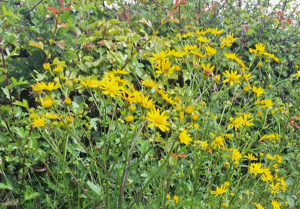What’s that Plant?
Date published:
With many farmed animals across Northern Ireland now out grazing, it is important to be aware of the risks from plant poisoning. There are many plants known to be toxic to animals particularly ruminants such as Rhododendron species causing vomiting, Yew leaves causing sudden death, Bracken plants causing blood loss in the acute phase and tumours in the chronic phase and Water Hemlock causing salivation, progressing to convulsions.

AFBI has seen an increase in submissions of carcasses in the last month exposed to another toxic plant called Ragwort, colloquially known as ‘Benweed’. Ragwort is a tall plant with a flat top containing a cluster of yellow daisy-like flowers, mainly seen growing between June to October. The main ‘weed’ version Senecio jacobaea favors light, free draining ground with thin vegetation for growth and when it flowers it can produce up to 60,000 seeds for dispersal.
The cases submitted to AFBI were from outbreak situations with multiple deaths affecting bovines around 12 to 18 months. These cases are unusual due to the season of presentation, with cases mostly seen in the autumn when there is poor grass availability.
Also, clinical signs are mainly seen in older animals as it usually takes weeks to months of ingestion and has been reported to take up to 18 months for clinical signs to be seen. It is important to note that pigs are the most susceptible followed by horses, however sheep are less prone to ragwort toxicity.
Disease is caused by the pyrrolizidine alkaloid that is produced by ragwort which causes liver damage. Two disease processes can occur with ingestion: an acute disease with large volume ingestion causing rapid death and acute liver damage. However, the acute disease is rare due to the unpalatability of ragwort.
The chronic disease with lower repeated ingestion is more common with signs occurring weeks to months after exposure. Clinical signs include diarrhoea with tenesmus, jaundice, weight loss and ascites. Severe liver damage can cause a buildup of ammonia leading to hepatic encephalopathy with signs of head pressing and weakness occurring prior to death.
Generally, most animals don’t like the taste of the fresh plant so most exposure occurs via ragwort which has been ensiled or made into hay, which makes it more palatable due to the release of sugar. However, animals that are on sparse grass or in fields with a high stocking density may have no option but to eat the plant.
Testing for pyrrolizidine alkaloid is not readily available and diagnosis relies on clinical signs, history of exposure, gross postmortem findings, and characteristic liver histology. Biochemical analysis of blood can indicate that liver damage is present. There is no treatment available for ragwort poisoning but all animals should be moved to clean fields or fed fodder which hasn’t been contaminated with ragwort.
Prevention of toxicity includes limiting exposure to ragwort by avoiding grazing affected fields, particularly if poor grass growth. Ragwort is included in the Noxious Weeds order of 1977 which places an onus on landowners to remove ragwort if it is a risk to agricultural ground. Removal of the ragwort plant is advised by pulling, cutting before flowering, ploughing of heavily contaminated pasture or judicious herbicide use.
When using herbicides animals must be removed from the field until ragwort is fully rotted, which can take up to 6 weeks, as it is more palatable after spraying. Due to the toxic nature of ragwort anyone touching it should wear appropriate gloves and cover exposed skin. All removed plants should be disposed of carefully to avoid the dispersal of seeds.
It is important to remember that the production of hay or ensiling makes ragwort more palatable, hence care should be taken to remove any ragwort from fields used for fodder. Promoting a dense and competitive pasture sward will also hinder its growth.
This article mentions only a few of the plants known to have toxicity to ruminants and farmers should check fields regularly for toxic plants growing in hedgerows or within the field. People should also be aware not to discard clippings from gardens into fields, as they often contain plants such as Flame of the Forest or Azelea which are the most common acute poisonings seen at AFBI.